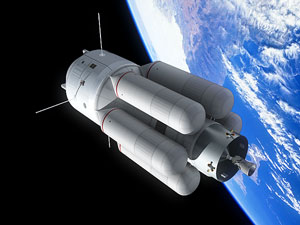Spacecraft: Current: Space Tugs
A single design of Tug will have to carry out all possible missions, either working alone or in a multi-stage configuration. For operations to the Moon a Tug with a maximum fuelled mass of about 12.5 tons seems optimum, although often it will be working with less than its maximum fuel load.
The same Tug will be equipped with landing legs and radar for making the descent and soft landing on the moon's surface.
 Dornier Space Tug
Dornier Space Tug
Since July 1970, the feasibility and economic aspects of an unmanned space tug intended for geostationary missions have been examined under ELDO contract by two European industrial consortia. Within the consortium headed by Hawker Siddeley Dynamics, Dornier Systems has been engaged on the conceptual design, mission analysis and economy studies of a space tug. In this connection, first considerations and investigations have been made by Dornier Systems for a multi-purpose, reusable and unmanned space tug.
As demonstrated by the mission analysis study, the space tug may be used for a broad mission and payload spectrum. To meet the various velocity requirements, the space tug propulsion system will consist of two basic modules - the core unit, including engines and auxiliary tank modules. As the propellant is contained in several tank modules, the quantity of propellant can be adjusted to suit the mission requirements by varying the number of auxiliary tanks.
